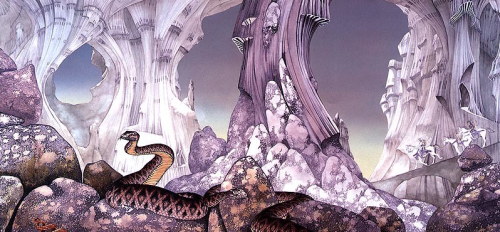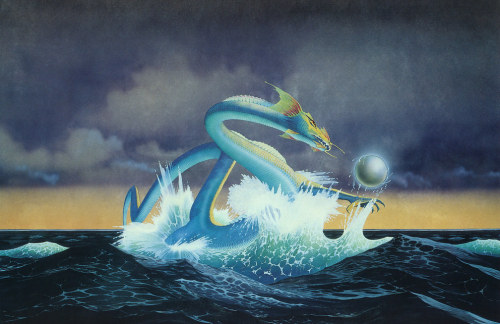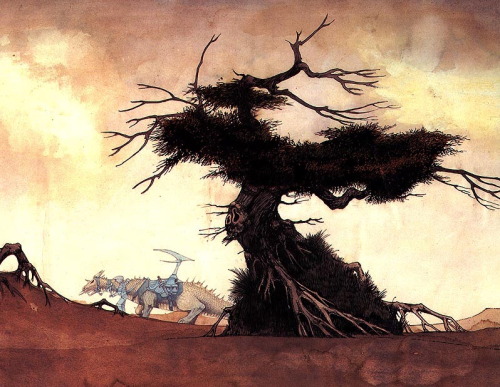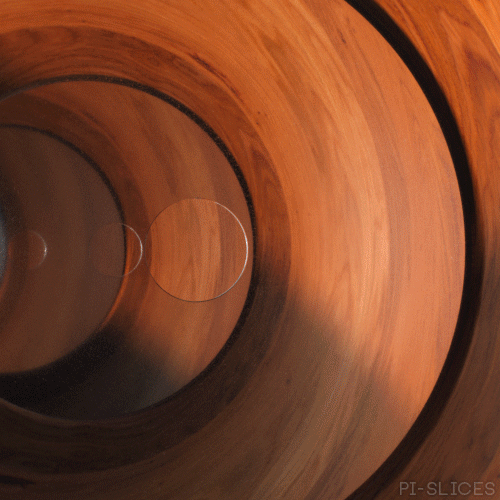Illustrations By Roger Dean.



Illustrations by Roger Dean.
More Posts from Epic-flight and Others

U.S. Navy Douglas A-1 Skyraider by Luccio Perinotto.

Preparing for the approach

A Colorful Moon The Moon is normally seen in subtle shades of grey or yellow. But small, measurable color differences have been greatly exaggerated to make this telescopic, multicolored, moonscape captured during the Moon’s full phase. The different colors are recognized to correspond to real differences in the chemical makeup of the lunar surface. Blue hues reveal titanium rich areas while orange and purple colors show regions relatively poor in titanium and iron. The familiar Sea of Tranquility, or Mare Tranquillitatis, is the blue area in the upper right corner of the frame. White lines radiate across the orange-hued southern lunar highlands from 85 kilometer wide ray crater Tycho at bottom left. Above it, darker rays from crater Copernicus extend into the Sea of Rains (Mare Imbrium) at the upper left. Calibrated by rock samples from the Apollo missions, similar multicolor images from spacecraft have been used to explore the Moon’s global surface composition. Image Credit & Copyright: László Francsics

Robert McCall

Space Shuttle Atlantis launch, 3 October 1985.

Circular Windows - 221006

SSTO Orbital Lander
Movie: Interstellar UI Design: Double Negative









“I would like to humanize the space age by giving a perspective from a non-astronaut, because I think the students will look at that and say, ‘This is an ordinary person. This ordinary person is contributing to history.’”
—Christa McAuliffe (September 2, 1948–January 28, 1986)
-
 thefatdood liked this · 8 months ago
thefatdood liked this · 8 months ago -
 widthofmytongue liked this · 1 year ago
widthofmytongue liked this · 1 year ago -
 rustedskyprisms liked this · 1 year ago
rustedskyprisms liked this · 1 year ago -
 lizard-of-oz reblogged this · 1 year ago
lizard-of-oz reblogged this · 1 year ago -
 catonthesun liked this · 1 year ago
catonthesun liked this · 1 year ago -
 willowthelostkid reblogged this · 2 years ago
willowthelostkid reblogged this · 2 years ago -
 willowthelostkid liked this · 2 years ago
willowthelostkid liked this · 2 years ago -
 lu-mineartsworld liked this · 2 years ago
lu-mineartsworld liked this · 2 years ago -
 horacio36 liked this · 3 years ago
horacio36 liked this · 3 years ago -
 cooldamegarcon reblogged this · 3 years ago
cooldamegarcon reblogged this · 3 years ago -
 arover liked this · 3 years ago
arover liked this · 3 years ago -
 captain-boobie liked this · 3 years ago
captain-boobie liked this · 3 years ago -
 things-for-journey reblogged this · 3 years ago
things-for-journey reblogged this · 3 years ago -
 captainodinmm liked this · 3 years ago
captainodinmm liked this · 3 years ago -
 daughtersofhorror liked this · 4 years ago
daughtersofhorror liked this · 4 years ago -
 virginlibertine reblogged this · 4 years ago
virginlibertine reblogged this · 4 years ago -
 virginlibertine liked this · 4 years ago
virginlibertine liked this · 4 years ago -
 twodeeze55 reblogged this · 4 years ago
twodeeze55 reblogged this · 4 years ago -
 twodeeze55 liked this · 4 years ago
twodeeze55 liked this · 4 years ago -
 deathsu-34fullback reblogged this · 4 years ago
deathsu-34fullback reblogged this · 4 years ago -
 lunar-solaris liked this · 4 years ago
lunar-solaris liked this · 4 years ago -
 zatoseyes reblogged this · 4 years ago
zatoseyes reblogged this · 4 years ago -
 happyboyart liked this · 4 years ago
happyboyart liked this · 4 years ago -
 bleukaiju liked this · 4 years ago
bleukaiju liked this · 4 years ago -
 luxurio1993 liked this · 4 years ago
luxurio1993 liked this · 4 years ago -
 eternal-jamie reblogged this · 4 years ago
eternal-jamie reblogged this · 4 years ago -
 xcreaseproofx liked this · 4 years ago
xcreaseproofx liked this · 4 years ago -
 graycewatson9 liked this · 4 years ago
graycewatson9 liked this · 4 years ago -
 epic-flight reblogged this · 4 years ago
epic-flight reblogged this · 4 years ago -
 princealiguap liked this · 4 years ago
princealiguap liked this · 4 years ago -
 imaginarylifeform reblogged this · 4 years ago
imaginarylifeform reblogged this · 4 years ago -
 humanmorph reblogged this · 4 years ago
humanmorph reblogged this · 4 years ago -
 janasthirdeye liked this · 4 years ago
janasthirdeye liked this · 4 years ago -
 museum-of-cow-tools reblogged this · 4 years ago
museum-of-cow-tools reblogged this · 4 years ago -
 1998alexandr liked this · 4 years ago
1998alexandr liked this · 4 years ago -
 yesdeliciousinternetstudent liked this · 4 years ago
yesdeliciousinternetstudent liked this · 4 years ago -
 pterobat reblogged this · 4 years ago
pterobat reblogged this · 4 years ago -
 bireyes-moved liked this · 4 years ago
bireyes-moved liked this · 4 years ago -
 multicarinata reblogged this · 4 years ago
multicarinata reblogged this · 4 years ago

